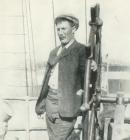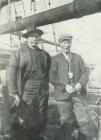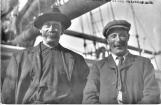1
Captain Bob Bartlett on the Roosevelt1908-09
Labrador
 Credits:
Credits:How Peary Reached the Pole; the personal story of his assistant, by Donald B. MacMillan. Boston, New York: Houghton Mifflin Co. 1934.
2
Bob Bartlett, Captain1908-09
Arctic region
 Credits:
Credits:The North Pole, by Robert E. Peary. London: Hodder and Stoughton. 1910.
3
Capt. Bob Bartlett and MacMillan1908-09
Labrador
 Credits:
Credits:The North Pole, by Robert E. Peary. London: Hodder and Stoughton. 1910.
4
Borup and MacMillan1908-09
Arctic region
 Credits:
Credits:How Peary Reached the Pole; the personal story of his assistant, by Donald B. MacMillan. Boston, New York: Houghton Mifflin Co. 1934.
5
Matthew A. Henson (he went to the Pole with Peary)1908-09
Arctic region
 Credits:
Credits:How Peary Reached the Pole; the personal story of his assistant, by Donald B. MacMillan. Boston, New York: Houghton Mifflin Co. 1934.
6
Commander Peary and Captain Bob Bartlett at Indian Harbour, Labrador, on the return from the North1909
Labrador
 Credits:
Credits:How Peary Reached the Pole; the personal story of his assistant, by Donald B. MacMillan. Boston, New York: Houghton Mifflin Co. 1934.
7
Commander Robert Peary and Captain Bob BartlettSeptember 1909
Labrador
 Credits:
Credits:Courtesy of Ted Hardy, St. John's NL
8
Robert E. Peary, Commander1908-09
Arctic region
 Credits:
Credits:The North Pole, by Robert E. Peary. London: Hodder and Stoughton. 1910.
9
Although Robert A. Bartlett, Donald B. MacMillan, Matthew Henson and Robert E. Peary are noted northern explorers in their own rights, their names are forever linked by the successful polar expedition of 1908-09.Captain Robert Abram Bartlett
Bob Bartlett, a Newfoundlander by nationality, was born in Brigus Newfoundland on Aug. 15 1875. A valued member of Peary's 1909 polar expedition, 'Capt Bob' was captain of the vessel 'the Roosevelt', and head of the last supporting sledge party which turned back at 87degrees 48 minutes (150 miles from the north pole). In recognition of his outstanding contribution to the success of Peary's 1909 polar expedition, Bartlett was awarded the National Geographic Society Hubbard Medal in 1909. In 1925, Bartlett bought his beloved vessel 'the Effie M. Morrissey'. After refitting the vessel, enabling it to withstand Arctic travel, Bartlett made 20 scientific voyages over the next 20 years into Arctic waters. His activities garnered the same level of public interest as contemporary space exploration. After a life-time in arctic exploration, Robert A. Bartlett died of pneumonia in New York City on April 28 1946.
Donald Baxter MacMillan
Born in Provincetown Massachusetts on Nov 10 1874 and educated at Bowdoin College as a geologist, Donald MacMillan was an accomplished researcher, lecturer, and Arctic explorer. As head of one of the supporting sledge parties, MacMillan suffered frost damaged to his feet and had to return to ship on March 14 from 84 degrees 29 minutes. At the end of military service in WWI, MacMillan began fundraising to build a ship for further Arctic exploration. In 1921 the schooner 'the Bowdoin' was launched and became a familiar name through its many journey north. In 1954 MacMillan was awarded the Bowdoin Prize given once every five years to a student or faculty member who had made a 'diistinctive contribution in any field of human endeavour'. Donald B. MacMillan died on Sept 7 1970 and is buried in Provincetown Massachusetts.
Matthew Henson
Born on Aug. 8 1866 in Maryland, Matthew Henson accompanied Robert Peary on seven Arctic expeditions and was co-discoverer of the north pole. He is now regarded as America's foremost black explorer, however his reception upon return to America in 1909 was distinctly cool. Recognition of his achievements have been largely posthumous. Matthew Henson died in 1955. In 1988 he was re-interred at Arlington National Cemetery.
Robert E. Peary
Born in Cresson Pennsylvaniia on May 6 1856, and educated at Bowdoin College, Robert Peary became the most famous Arctic explorer with his successful polar expedition of 1908-09. During the 1890's Peary made several journeys north and contributed to scientific knowledge of the area – amongst other contributions he determined that Greenland was an island and established its northernmost limits. During these explorations he determined that a route to the north pole departing land from Ellesmere Island would be more viable than a Greenland route. It was also during these expeditions that gained knowledge about and skills in survival and travel in the north. Combining the seamanship skills of Bartlett with the knowledge gained over years of northern experience and the determination of a route departing from Ellesmere Island culminated in his attainment of the north pole in 1909. Robert E. Peary died on Feb. 20 1920 and was buried at Arlington Cemetery.